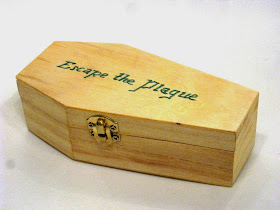What I am not certain is the wood that was used to make the puzzle; guess I will have to wait until more owl information reaches me early next year. What about quality and construction? No guesses needed. It is very well made with fine finishing and attention to detail.
I was wondering if the object was to open the top or release a drawer... but nothing of either sort. After some fiddling with the puzzle, the goal as I discovered, is to get the owl's head (which appears half-recessed into its body) to extend fully.upwards. As though something had caught the owl's attention! I played with it some more but there appears nothing more to solve. [Please see edit below]
Like my earlier Kakuda puzzle, the Skunk Attack, this one takes just 2-3 moves to solve and very easy too! Notwithstanding, I still like the owl which is really high on the cute factor, with nice eyes and a beak.
[Edit 1st Jan 2015 - Two well known puzzlers in the community (Louis Coolen and Peter Hajek) contacted me to let me know there's one more step to go for the Owl to reveal a secret compartment. I went back to the Owl and lo and behold, I found it...well hidden. I should have looked at the Owl more carefully during play...silly of me to have missed it]














































